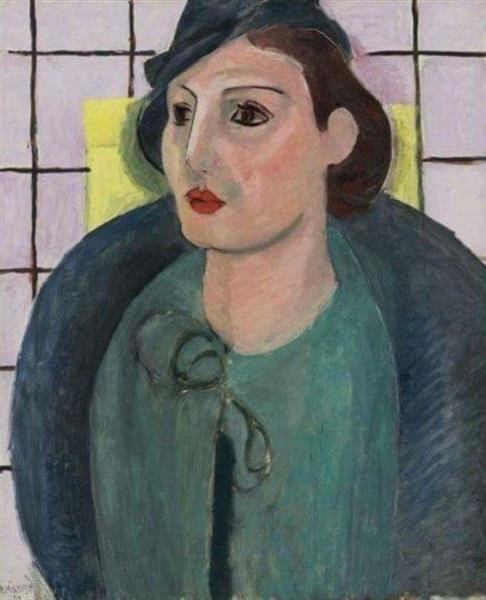Description
Henri Matisse, one of the most influential painters of the 20th century, presents us in "Titine Trovato in Dress and Hat" (1934) a work that perfectly encapsulates his mastery in the use of color and form. In this painting, Matisse offers us a representation of Titine Trovato, a female figure that emerges from an abstract background with a magnetic presence and innate elegance.
The composition of the work is particularly notable for its simplicity and energy. The figure of Titine is located in the center of the canvas, becoming the absolute focal point of the viewer's gaze. This centering adds a sense of balance and stability to the work, despite the dynamism of the surrounding colors and forms. Titine's silhouette is defined by bold and contrasting lines, mainly in dark tones, that make up her dress. However, it is the hat that immediately captures attention. Large in size compared to the woman's head, the hat is a statement of style and a representation of the character's sense of fashion.
Color, once again, plays a fundamental role in Matisse's work. The palette used in "Titine Trovato in Dress and Hat" is characterized by the presence of dark and earthy colors in the clothing, contrasted with a background of softer and lighter tones. This chromatic contrast accentuates Titine's figure, giving her a special luminosity. Likewise, the patterns in the background, almost abstract, suggest a vibrant but non-invasive environment, allowing the central figure to remain sharply defined.
This use of color and form is emblematic of Matisse's mature style. His ability to synthesize the human figure and the environment into elemental forms, without losing the referential essence of his subjects, places him as an undisputed master of modern art. In this particular painting, the figure of Titine, with her clothing and headwear, reflects not only a personality but also an era, encapsulating the styles and sensibilities of the 1930s.
Henri Matisse began to approach the human figure with an increasingly simplified and expressive focus in the 1930s, moving away from the more detailed portraits of his early years. This transition can be clearly observed in "Titine Trovato in Dress and Hat", where anatomical accuracy gives way to a more stylized and abstract representation, focusing on the expression and energy of the figure.
Matisse's influence on the development of modern art cannot be underestimated. His continuous exploration and ability to reinvent his style allowed him to remain relevant and revered in the changing artistic landscape of the 20th century. Works like "Titine Trovato in Dress and Hat" not only reflect his artistic evolution but also his profound understanding of the human form and his ability to communicate through a vibrant and emotional visual language.
In summary, "Titine Trovato in Dress and Hat" is a sublime representation of Henri Matisse's artistic genius. Through his masterful use of color, form, and composition, Matisse not only offers us a unique vision of a singular figure but also invites us to reflect on the transformative power of art. This work, like so many others in his vast career, underscores why Matisse occupies a prominent place in the history of world art.

